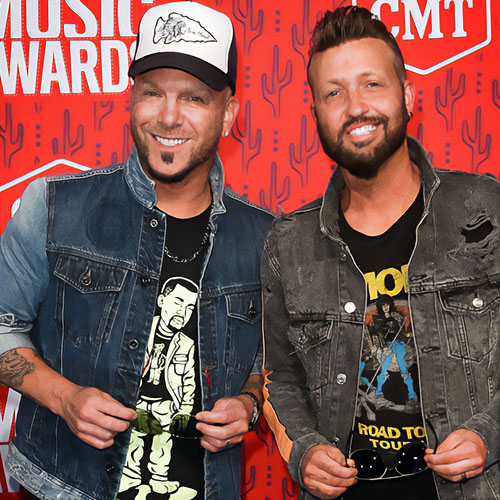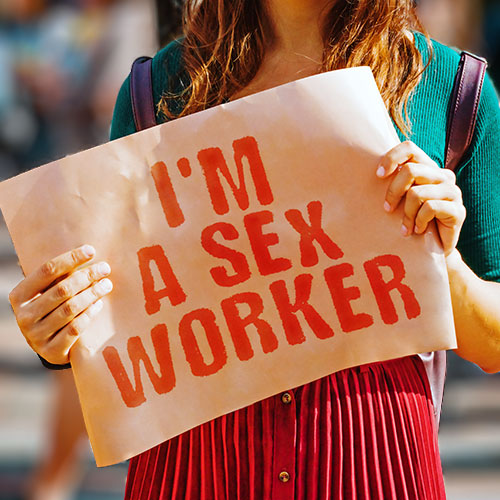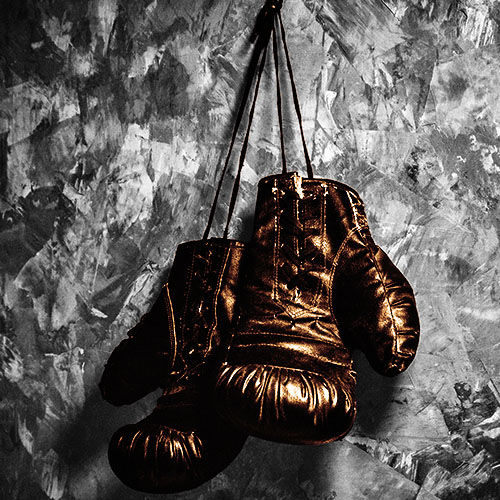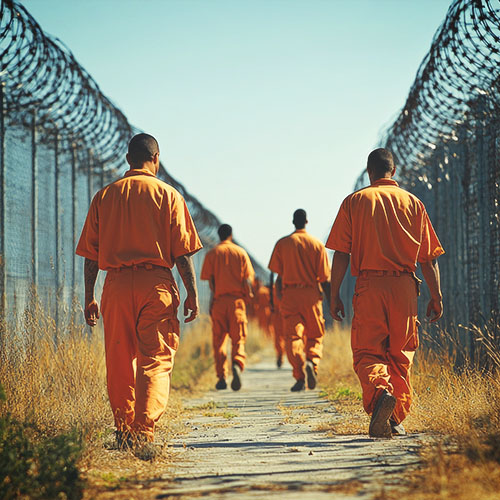Violent crime is subsiding throughout the United States, but not on the wretched reservations where Native Americans exist in poverty and despair. The horror will continue unless a lost generation of young Indians can somehow find salvation.
Red Men Walking
“Do you believe in god?”
Those may have been the last words ever spoken by16-year-old Jeffrey Weise. He spit them out as he stared along the barrel of his gun at a trembling teenage boy in a classroom at Red Lake High School in March. It was the same question Dylan Klebold and Eric Harris asked one of their victims years earlier during the massacre at Columbine. There is no record of whether this boy answered. There is ample documentation of what happened next. With no trace of regret on his round baby face, Weise pulled the trigger. His victim was lucky — he was only wounded.
Weise was then in the final moments of one of the bloodiest school rampages in U.S. history. It began earlier that afternoon when Weise, a disturbed Ojibwa Indian who fancied himself a kind of neo-Nazi, stormed into his grandfather’s house. He armed himself with a .22-caliber rifle. He murdered his grandfather, 58-year-old Daryl Lussier, a tribal cop at Red Lake, and gunned down the man’s girlfriend, 32-year-old Michelle Sigana. Donning his grandfather’s bulletproof vest, Weise stole the rest of Lussier’s guns and his patrol car, then drove the roughly two miles to Red Lake High School, from which he had been suspended earlier in the year.
At 2:55 P.M., Weise burst through the metal detector at the front door of the school. When 28-year-old security guard Derrick Brun confronted him, Weise shot and killed him. For the next ten minutes, as students and teachers cowered in terror behind locked doors or tried to flee, Weise stalked the hallways and classrooms. He was, by all accounts, oddly detached. Witnesses say he smiled and waved at some students, while murdering others. He burst into one classroom and executed 62-year-old English teacher Neva Rogers. Before he was done, five students would be dead and 15 others wounded.
Then, wounded slightly after trading gunfire in a hallway with reservation cops, Weise hobbled into a classroom. When he fired his last shot, perhaps Weise was thinking about how his father had died a few years earlier — with a bullet to his own head after a lengthy standoff with reservation police. Authorities are certain of only one thing that went through the teenager’s head in that classroom: a bullet from his own gun.
Jeffrey Weise had made no secret among his few friends of his bloody fantasies or his reverence for Adolf Hitler. Authorities now suspect he may even have shared his plans to attack the school with some of his closest friends
When they found Melvin Sipe, he was curled up on the floor of his home. His bloodstained nightshirt was hiked up over his knees. His bony hands were all but welded over his eyes — apparently he had seen what was coming. He might even have tried to fight off his attacker. But at 82, Sipe was no match for16-year-old Craig Lee Sturdevant, a Native American crackhead whom authorities charge had broken into Sipe’s home that day in September 2002.
A few feet away lay the body of Sipe’s dead wife, Dolores. The woman also had been beaten and then shot execution-style.
It was a typical drug-crazed burglary gone bad, officials said, the kind of crime that barely raises an eyebrow when it happens in Chicago, Minneapolis, Milwaukee, or Detroit. But this was Hayward, Wisconsin, a pine-ringed burg at the north-western edge of the state, a tourist town where sudden death is usually reserved for whitetail deer during hunting season. Certainly there had been rumblings of violence and crime on the nearby Lac Courte Oreilles Ojibwa Reservation. For nearly a decade, young gangsters — many of them linked to the notorious Latin Kings — and other criminals had been making their presence felt there. But until recently there seemed to be little to fear in Hayward.
Then, in the months leading up to the Sipe slayings, the violence that had been confined to the reservation began to take on a more menacing tone. There were drive-by shootings, arsons, and beatings, some of them brutal beyond imagination. And now the violence had spilled off the reservation.
His clothes were still splattered with blood and brain matter, his ears still ringing from the blast of the stolen rifle, as14-year-old Darryl Headbird stumbled into the kitchen of the run-down government-issue house in a desolate corner of the Leech Lake Reservation in northern Minnesota.
The boy grabbed a bottle of bleach and headed back into the living room. He looked down at the body of his father, Darryl Headbird Sr. He felt nothing. No guilt. No shame. No rage. “That’s the strange part about it,” the now-18-year-old Headbird told Penthouse in an interview from the Minnesota prison where he will remain until he’s well into his forties. “I don’t think I was angry.”
Looking back, Headbird realizes his old man “wasn’t a bad father.” He hadn’t really wronged him. In the grand scheme of things, he hadn’t been any worse than tens of thousands of other fathers on Indian reservations all across the country. Yes, there were the problems with money and with the bottle, but the worst thing Darryl Headbird could say about his dad was that he had terrible taste in music.
That’s what made it all the more stunning, even to Headbird, that he had murdered his father in cold blood, firing a single bullet from a stolen gun directly into his face as he slept.
He had planned it all and even rehearsed it in his mind earlier that night in late May 2001 while hanging with his friends at the reservation skating rink. He covered every detail, right down to his decision to kill the family dog, bashing in the poor mongrel’s skull with a baseball bat. He still sees that as an act of kindness. After all, once Dad was dead, “who was going to feed him?” Certainly not Darryl, who planned to flee with his 13-year-old girlfriend, Sierra Goodman, to Duluth and points beyond, to start what he has since described as a kind of goth coven. Darryl knew his father would try to stop him. That’s why he had to die.
He poured the bleach on his old man’s body. The newspapers would make much of that, suggesting that Darryl had stayed by his dead father’s side and cared for his body. The truth was, he told Penthouse, he wiped down his father’s bleeding corpse “basically to speed up the decomposition … to wipe away evidence and all that.”
Then he left the house. Within the next few hours, he would try— with the same cold determination — to murder Sierra’s adoptive parents when they stopped them on the road leading off the reservation. Using the knife techniques his father had taught him, he stabbed the girl’s stepfather in the throat and severed the woman’s spinal cord just below the neck. They survived, barely.
Reservations: “A WAKE-UP CALL”
Three heinous crimes. Three young men. None out of his teens when he killed. It’s tempting to think of these as isolated incidents-horrific and aberrant crimes committed by freakish loners whose only common thread is the depravity of their fantasies and the sheer brutality of their actions.
But go just below the surface, and there is something else that links the three crimes. All involved young Native Americans, kids who had grown up in what government officials and Indian leaders privately acknowledge is a bubbling cauldron of crime and violence on America’s 564 Indian reservations. All had been raised with the four horsemen of the Indian apocalypse — substance abuse, suicide, poverty, and despair — charging through their lives.
By any measure, life on America’s Indian reservations is harsher than almost anywhere else in America. Alcoholism and drug abuse are pandemic. In 1997, the most recent year for which statistics are available, Indians were arrested for alcohol-related offenses at a rate twice that of all other races. That, say experts, doesn’t even begin to count the numbers of Native American adults and youngsters who manage to keep their substance abuse a secret from the undermanned and overwhelmed police departments trying to keep a semblance of order across millions of acres of Indian land. It also doesn’t take into account the pernicious problem of fetal alcohol syndrome, which, according to the American Indian Health Council, may afflict more than one in every four people in Indian country — Darryl Headbird among them — bringing with it mental illness and, in some cases, retardation.
The suicide rate for all Indians is 50 percent higher than the rate for the population at large, and among young Indians, it’s three times the national rate. It is the second-leading cause of death among Indians between the ages of 15 and 24. At Red Lake alone, according to one recent report, eight in every ten high school girls said they had considered suicide; 20 percent said they had tried it at least once. Even Jeffrey Weise once mused on a Website that he had considered taking “the razor express.”
And then there’s crime — not just the spectacular slayings that rocked Red Lake, Lac Courte Oreille, and Leech Lake, but also the numbing, relentless kind of crime that happens every day on reservations all over the country. On any given day, one in every 25 Indians over 18 is likely to be in jail, 2.4 times the per-capita number for Caucasians.
In fact, while the violent-crime rate overall in America has declined over the past several years, it remains a seemingly intractable problem in Indian country. According to U.S. Justice Department statistics, Native Americans, who account for just over one percent of the nation’s population, are nearly two and a half times more likely to be the victims of violent crime than any other ethnic group. One in every four Indian kids between the ages of 18 and 24 can expect to be a victim of violence, and when an Indian kid is murdered, there’s a 70 percent chance that the killer will be another Indian kid.
But reality is a lot uglier than statistics.
Reservations: “EVERYONE LOOKED UP TO THOSE GUYS”
Drive onto almost any reservation in America, and you can feel the despair.
Take Lac Courie Oreille, for example. Set deep in the loamy pines of northern Wisconsin, ringed by million-dollar vacation homes, it’s a sprawling 76,000-acre tract of despair.
The poverty rate is staggering: Lac Courie Oreille is one of the four poorest reservations in Wisconsin. (There are eleven.) The unemployment rate languishes around 60 percent. It’s a place where broken families live in disintegrating cracker-box houses. And it takes its toll. You can see it in the eyes of the children, says Dave Anderson, an Ojibwa who served as chief executive officer for Lac Courte Oreille before taking over the reins at the Bureau of Indian Affairs. “When you get a group of our youth together, you don’t see that spark and that enthusiasm like you do in other communities,” he says.
But for all its isolation, it’s only a few hours’ drive from major cities. These cities are especially alluring because, say Indian leaders, after generations of inconsistent government policies and cultural ennui, traditional Indian values have been eroded.
Too many Indian kids suffer from terminal invisibility. In a world where cultural values have been uprooted, every path off the reservation is equally unfamiliar. Even when they adopt these foreign ways, young people still try to cling to something that is unalterably Indian.
Trinkets have replaced traditional values. “Anytime you go to an Indian community, they always talk about, you know, we need to be passing down our culture and our traditions to our youth,” says Anderson. “I think somewhere along the line, we have really forgotten about the real reason why we respected our elders …. The reason why we respected our elders and our forefathers is because they were able to survive successfully in the environment that they lived in …. And today we have confused this culture of survivorship with folk art; today, when we talk about passing down traditions and culture, we talk about passing down how to do quilting, how to do beadwork, how to weave a basket.”
With nothing to moor these disparate communities to their past, say Anderson and others, there has been a growing tendency to accept without question the superficial promises of the opulent, consumer-driven American culture.
More often than not, the promise turns out to be a mirage. “Where they could afford to live was usually in high-poverty, high-crime … gang-infested areas of the cities,” says Karen Harden, a member of Wisconsin’s Juvenile Justice Commission. Over time, the young transplanted reservation Indians picked up the swagger, the jargon, and the skills of the inner-city streets. Many young Native American women married gang members and returned, bringing their spouses and the contagion of urban crime, which thrived on the reservations. At Lac Courie Oreille, the Latin Kings, one of the most violent and well-organized street gangs in the country, exploited the weaknesses of reservation life and all but colonized the place. It’s a common problem in Indian country.
At Lac Courte Oreille, a place where kids were growing up with nothing, including hope, the Latin Kings seemed to offer a way out, says Michael Demain, a former member of the gang. “Everybody, you know, looked up to these guys …. They came from the cities …. They were cool, you know, ’cause they had new shoes, hats that were cool, jackets …. Everybody real quick thought they were cool, and they were claiming Latin King.”
Over the course of a decade, violence spiked, and Sawyer County and the Lac Courte Oreille Reservation became among the most dangerous places in the state. But it wasn’t until the violence seeped off the reservation with the Sipe slayings that authorities finally sat up and took notice. Last summer, 26 people on and off the reservation, including the alleged leader of the local faction, were indicted on drug charges. So far, more than a dozen have been convicted and sentenced to between 10 and 20 years in federal prison.
The Reservation: ALIENATED, ANGRY, AND ADRIFT
Across the United States, authorities on Indian reservations are under siege. Gangs are a critical issue. The Justice Department estimates that gangs are active on 300 of the 564 reservations nationwide. On just one reservation — South Dakota’s Pine Ridge, the rocky, barren wasteland known for the Wounded Knee Massacre — authorities estimate that 3,000 of the 25,000 residents swear allegiance to one gang or another.
Tribal officials have long fretted over the lack of money for programs to catch kids before they go bad. Though the Justice Department and tribal leaders across the country have been working with some success in recent years to develop juvenile-justice programs, funding has been scarce — and has been growing scarcer under the Bush administration. There is still little available to handle young offenders early in their criminal careers. In all of Indian country, there are only ten juvenile facilities, though the federal government has funded 16 more to be built in the coming years. That, in addition to the lack of law-enforcement officers, experienced tribal courts, and the absence of any real mechanism to deal with young offenders, means that everyone — from teachers to social workers to cops — often look the other way until young offenders’ crimes are so bad they can no longer be ignored.
“Our young people are walking around today and they have no identity, ” says Clyde Bellecourt, founder of the Minneapolis-based American Indian Movement. “What do they identify with? Where’s their family? They go home to alcohol and drug abuse, overcrowded conditions, unemployment, sometimes sexual abuse.”
“Our young people, even our Indian kids who belong to these gangs, are … tattooing medicine wheels on their arms,” Bellecourt says. “They are trying to be warriors, but … a warrior isn’t somebody who just goes out and shoots people and calls their sisters and girlfriends bitches and whores. A warrior is a person who goes out and protects … who takes care of the community. And [these kids] got that all mixed up.”
Leaders like Bellecourt have been reaching out to Indian youth. On several reservations — including Red Lake — authorities have worked with the federal government to develop holistic programs designed to steer potentially troubled kids into programs that rely on traditional Native American techniques that focus on community involvement and counseling over punishment. Some even operate cultural-immersion programs in which at-risk teens are rigorously drilled in native ways.
There are no authoritative studies on whether those programs are working, but Ada Pecos Melton, a highly regarded researcher, says she is optimistic.
“I think those kinds of … things are trying to whittle away at a huge problem. The problem didn’t happen overnight, and so the solution can’t be expected to happen overnight either,” says Melton. “This is one of the ways to whittle away at this huge problem … and you cannot … say stop doing that or it doesn’t work, because it’s too soon to know. But they have got to do it.”
Obviously this article originated a decade ago and talks about many a heinous reality, but a tangential aspect took up most of the conversation here. As it turns out, the statistics on school shootings since the above-mentioned Columbine are nothing short of staggering. We do not want to get bogged down in the politics of all of this, but we will wonder freely why it became political at all. Problems with too many variables in causation just seem to light people up — if you’ll pardon the expression. Somebody needs to lock ’em in a room until the politicians come out with a plan. Sure, it may not work, but then we just try another plan. Doing nothing sure has not made anything better.
























